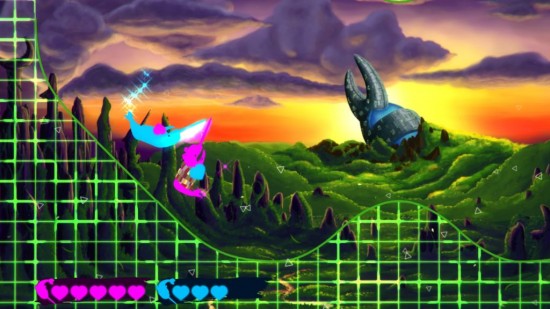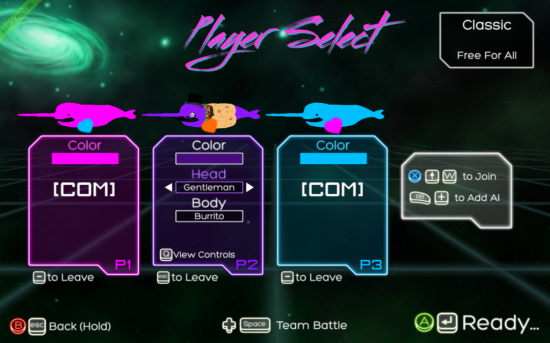Publisher: Breakfall
Developer: Breakfall
Medium: Digital
Players: 1-4
Online: No
ESRB: RP
We’ve got a lot of indie games bubbling up in all corners of the ‘net these days. It’s great, it’s experimental, and at times nakedly naive. Projects from up-and-comers are chomping at the same bit that would-be’s with immature ideas are vying for — both drawing different eyes to their games. Starwhal falls somewhere into a grey area of this spectrum, between careful decision-making and a polished up game jam spec people will probably pay for.
It’s also an ostentatious time, with “joke” games attracting people happy to shell out a few bucks for a giggle. This is more the target that Starwhal seems to be seeking out, with a subtitle of “Just the Tip” that hopes it’s clever enough for someone who gets a dick joke and repeat it to their friends. It’s catchy, at least. And, it’s publicity for an otherwise unassuming game based on the silliness of wiggly mechanics behind sea life jousting at each other.
At its heart, Starwhal is actually kind of cute. Its gameplay based on the clumsy nature of piloting a narwhal, in order to land a strike on an opponent’s body by squirming and fumbling about each other. In its greatest dreams, Starwhal would be a tightly-controlled game about pirouetting smartly from the edge of a wall into the heart of your opponent, but reality shows a game that entertains based on the sloppiness of its execution. For what is there, the hodgepodge of faux-80’s, space, and forced wackiness are at least honest about the game having no sense of direction.
In a lot of ways, Starwhal reminds me of Sonic the Hedgehog’s lurch into 3D. Certainly, at a time, Sonic’s mechanics were a great idea — perfectly tailored to the 2D platform genre he was born into. We were impressed with the blast processing power which whipped us through the thoughtfully-designed levels which complimented that gameplay. Once a third dimension was added, the accessible nature of 2D platforming was revealed to be all SEGA had a grip on, with no clear means of how to adapt.
Starwhal is similarly dead in the water when taken out of its original idea that players would struggle to outwit and outperform an opponent in an arena. Breaking targets, obstacle courses, even a score timer add nothing past the versus mode. The only purpose these modes ultimately serve is to reveal how light Starwhal is on ideas once it’s left the gate. Not only are they demonstrations of how the mechanics are only suited for playing against others, but ones which feel tossed in to give any sense of value past the 15 or so minutes that Versus mode takes to give a full picture of the game.
If there had been at least three other ideas as interesting as Starwhal’s core, or at least three times as much work put into understanding and refining the gameplay, we could be talking about the next must-have indie thing. I wouldn’t even mind so much the lack of online multiplayer if Starwhal didn’t become so boring within the span of a half hour locally.
For all the invention in video games, there’s even more that never surfaced due to being incomplete. We’ve seen some of it in AAA titles, but with the access that indie games have to an audience, and vice versa, the bar for ideas worth presenting becomes much lower, and much less of a hard line. A game like Nidhogg is a similar, incredibly slim and simple jousting idea, but one which has been developed within its limits, taking full advantage of its mechanics, and with a sense of identity to anchor it — where as Starwhal seems to think it’s well enough that the game supports controllers. What we’re left with is an idea that sounds silly, with a title that sounds silly, and a game that we’d be silly to give any more thought to.







